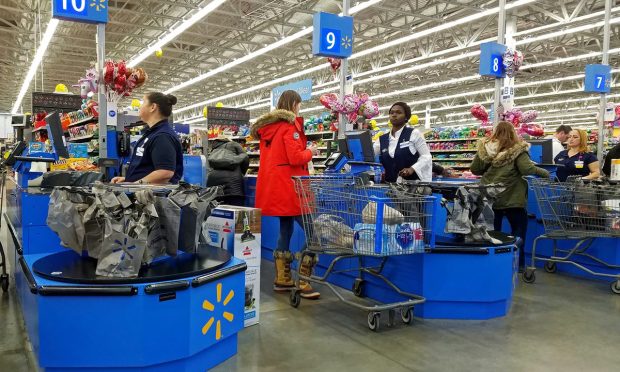AMZN vs WMT Weekly: Awaiting Insight on Inflation and in-Store Shift

If Walmart’s performance during the three-month window from February through April is any indication, then the retailer’s earnings for the corresponding period ought to be very strong when it reports its fiscal first-quarter results Tuesday (May 17) morning.
Although its archrival Amazon has struggled mightily for the past six months, as have the broader markets to a lesser degree, Walmart’s present path has been relatively smooth, as its defensive appeal, low prices and legion of stores have served it well this year.
Not long ago, Walmart was being derided for over-reliance on the 5,000 large-format U.S. stores that dot the American landscape in cities, towns and hamlets across the country. Today, those physical locations are being viewed in a different light, not only as community hubs but for the new roles as digital fulfillment centers, healthcare clinics and convenient banking outlets.
“Our strategy is coming to life,” Walmart CEO Doug McMillon said three months ago when discussing the retailer’s fourth-quarter results, pointing to recent investments in its burgeoning advertising business and financial services as well its core commitment to be consumer’s trusted primary shopping destination.
“The big basket stock-up trip is important. It’s foundational to our relationship with families,” McMillion said. “We earn that shopping occasion by running great stores and clubs and offering seamless pickup and delivery experiences, including for our Walmart+ and InHome [delivery] members in the US,” he added, while also noting the growth of its digital business, which went from 6% to 13% globally last year.
Of course, since McMillon spoke those words in mid-February, war has broken out in Ukraine, China has aggressively locked down its economy to stem COVID and gasoline prices and inflation have both set new records.
By most measures, 2022 has been a brutal year for consumer-facing businesses that sell full-priced non-discretionary goods, but for Walmart, it has not been awful as its stock is up 2% year to date. That might seem benign but when compared to the 16% drop for the S&P 500 and the 35% drubbing that has befallen shares of Amazon, and the outcome in Arkansas starts to look pretty good.
The challenge, of course, will be in Walmart’s ability to retrain customer habits and then retain them once inflation subsides and the economy regains its footing. How long that will be is anybody’s guess, but conventional wisdom suggests Walmart could have another year to reorient itself and its customers to the omnichannel era.
To that point, Tuesday’s results will offer great insight into how consumer habits are changing and what Walmart is doing to earn customers’ trust, not only as the place to do “big-basket stock-ups” but a whole lot more.
Amazon’s Answer
While Amazon already had its say in late April, the earnings aftermath for it has been challenging, and left the online retailing giant largely powerless to change a narrative and negative bias that has led to a wholesale sell-off of virtually all digital platforms, marketplaces and D2Cs.
Even so, Amazon continues to try to change the conversation via efforts to highlight value to its customers and subscribers wherever possible. For example, the company unveiled another big push for the expansion of its Alexa ecosystem this week — the second such effort in as many months — by adding new features that make it easier for family and caregivers to remotely look after aging loved ones.
By adding two new features specifically targeted at this large and growing market, the company’s blog post announcement said its enhanced Alexa Together offering with the new Circle of Support feature was “designed to help aging customers feel more comfortable and confident living independently and to give their families peace of mind.”
Other efforts gaining attention this week include things such as the upsized broadcast partnership with the NFL to carry Thursday night games on Prime Video, as well as reports that its tapping local “Mom and Pop” shops to held with rural deliveries, and also offering unbranded packaging to help grow its logistics and multi-channel fulfillment service to new merchants.
